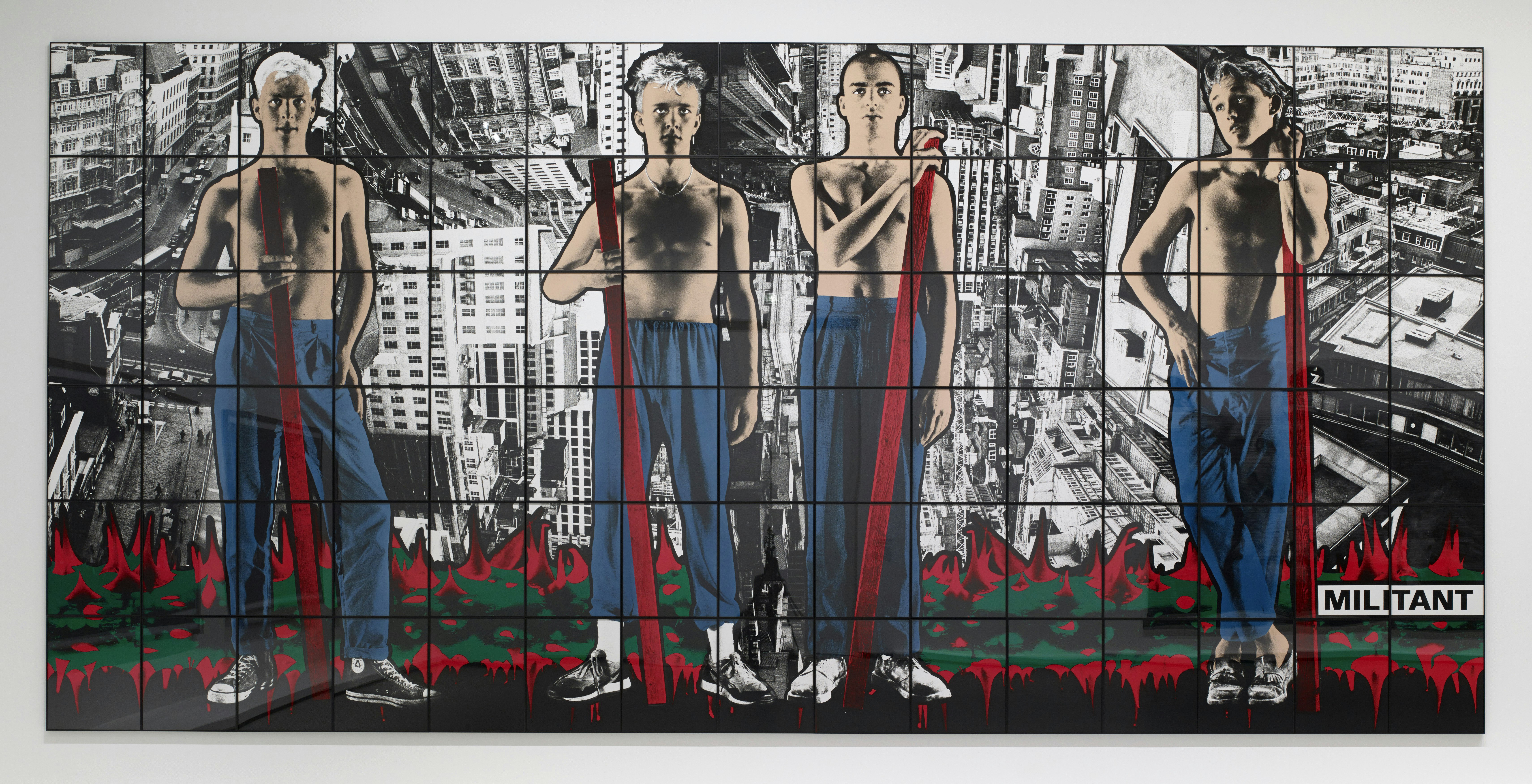Gilbert & George - Class war, militant, gateway

© Gilbert & George. Photo © Louis Vuitton Malletier
- Date
- From 14.10.2021 to 06.03.2022
- Place
-
Espace Louis Vuitton Tokyo
-
Omotesando Bldg 7F 5-7-5 Jingumae Shibuya-ku
-
Tokyo 150-0001
- Phone
-
+81 3 3515 0855
Pursuing the Fondation Louis Vuitton’s mission of showcasing exclusive holdings of the Collection to a broader international public, the Espace Louis Vuitton Tokyo presents for the first time in Japan the iconic monumental triptych Class War, Militant, Gateway (1986) by Gilbert & George, within the framework of the ongoing “Hors-les-murs” programme. This programme unfolds at the Espaces Louis Vuitton in Tokyo, Munich, Venice, Beijing, Seoul and Osaka.
Gilbert Prousch (b. 1943 in San Martin de Tor, Italy) and George Passmore (b. 1942 in Plymouth, United Kingdom) met in 1967, at Saint Martin’s School of Art in London. Soon after, they decided to form a duet, Gilbert & George, giving as early as 1969 one of their first public performances: Singing Sculpture. In this piece, they stood on a table, faces made up with bronze powder, and intonated Bud Flanagan and Chesney Allen’s song Underneath the Arches from the eponymous 1937 movie by Canadian director Redd Davis. Introducing their “living sculptures” concept, this performance took one of the ambitions of 20th- century art – to abolish all distinctions between art and life – and made it their own. In their conventional suits and ties, Gilbert & George literally embodied characters: maintaining an impassive expression in any circumstances, they struck poses in galleries and museums like statues.

Gilbert & George, Militant de Class War, Militant, Gateway, 1986
© Gilbert & George. Photo © Fondation Louis Vuitton / Marc Domage
In 1971, they started to use photography in an effort to promote an “art for all”, recycling from a grab bag of popular British and international culture that has been shaped and broadcasted by the media. Religion, sexuality, death and violence splashed across the cover pages of tabloids became the principal themes of their compositions, inspired by their lives in a working-class neighbourhood in the East End of London where they settled at the beginning of their joint career. Gilbert & George developed a new kind of humanism with a universal content, and yet refused to impose an unequivocal interpretation of it. Their famous photo montages are rigorously composed according to precise rules: first black-and-white, then colourised, and their configuration in grid has often been compared to stained glass. The use of computer graphics, that they started in 2004, enabled them to produce increasingly sophisticated allegorical compositions.
The Collection features a considerable ensemble of works by Gilbert & George dating from 1971 to 2019 that has been completed with pieces from their latest series. A manifesto for a modern epic poem, Class War, Militant, Gateway (1986) was their first monumental piece. It illustrates the individual’s adventure, from affiliation with a community to the emergence of a personal conscience and self-affirmation. As in most of their works, the images are arranged in a grid of black frames to form a frieze dominated by red, white and blue. Gilbert & George substitute the vertical “pyramid of oppression” by the horizontality of a society that no longer appears to be divided according to class. This democratic harmonization is represented here through work blues (whether simple trousers or gym shorts) in which all the characters in the foreground are dressed to the waist.
Gilbert & George’s work has not been shown in Japan since 2009. The Espace Louis Vuitton Tokyo is all the more honoured to present this exclusive masterpiece from the Collection.
The artist
Gilbert & George
Soon after graduating from Saint Martin’s School of Art, where they met in 1967, Gilbert & George rose to fame through their self-proclaimed “living sculptures”.
Wearing conventional suits, their faces impassive and covered with coloured powder, they perform a 1930s song, Underneath the Arches, an anthem of the lower classes, choosing to distance themselves from their immediate artistic entourage, who were more formalist and conceptual. In everyday settings, they walk, sing, read and drink, building up a body of visual material that they assembled from the early 1970s, first in black and white, then in colour, in grid formats that have frequently been compared to stained glass. Proclaiming it as “art for all”, they developed a new humanism with a universal content while refusing to provide an interpretation. Religion, sexuality, death and violence, the stuff of tabloid headlines, are the main themes of their compositions, which are inspired by their life in a working-class area of East London, where they have lived for all of their artistic career. In 2004 they began to use computers to create increasingly sophisticated allegories reflecting changes in contemporary society.


